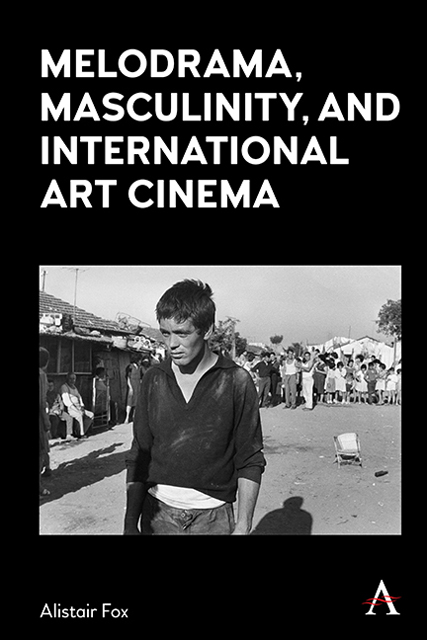Book contents
- Frontmatter
- Dedication
- Contents
- List of Figures
- Preface
- Acknowledgments
- Introduction
- Chapter 1 Italian Neorealism and the Emergence of the Male Melodrama: Vittorio De Sica’s Bicycle Thieves (1948) and Umberto D. (1952)
- Chapter 2 The Migration of Male Melodrama into Non-Western Cultures: Satyajit Ray’s The Apu Trilogy (1955–59) and “Fourth Cinema”
- Chapter 3 Hollywood Melodrama as a Vehicle for Self-Projection: Vincente Minnelli’s Tea and Sympathy (1956) and Home from the Hill (1960)
- Chapter 4 The Political Turns Personal: Neo-Neorealism and Pier Paolo Pasolini’s Accattone (1961)
- Chapter 5 Personal Cinema as Psychodrama: Ingmar Bergman’s Wild Strawberries (1957), Winter Light (1963) and Hour of the Wolf (1968)
- Chapter 6 François Truffaut and the Tyranny of Romantic Obsession: The Soft Skin (1964), Mississippi Mermaid (1969) and The Woman Next Door (1981)
- Chapter 7 Figuring an Authorial Fantasmatic: Jacques Demy’s The Umbrellas of Cherbourg (1964), A Room In Town (1982) and Parking (1985)
- Chapter 8 Rainer Werner Fassbinder and the Emergence of Queer Cinema: The Merchant of Four Seasons (1972), Fox and His Friends (1975) and In a Year with 13 Moons (1978)
- Chapter 9 Visual Aestheticism and the Queer Prestige Melodrama: Call Me by Your Name (2017) and Luca Guadagnino’s Desire Trilogy
- Conclusion
- List of Films Cited
- Select Bibliography
- Index
- Frontmatter
- Dedication
- Contents
- List of Figures
- Preface
- Acknowledgments
- Introduction
- Chapter 1 Italian Neorealism and the Emergence of the Male Melodrama: Vittorio De Sica’s Bicycle Thieves (1948) and Umberto D. (1952)
- Chapter 2 The Migration of Male Melodrama into Non-Western Cultures: Satyajit Ray’s The Apu Trilogy (1955–59) and “Fourth Cinema”
- Chapter 3 Hollywood Melodrama as a Vehicle for Self-Projection: Vincente Minnelli’s Tea and Sympathy (1956) and Home from the Hill (1960)
- Chapter 4 The Political Turns Personal: Neo-Neorealism and Pier Paolo Pasolini’s Accattone (1961)
- Chapter 5 Personal Cinema as Psychodrama: Ingmar Bergman’s Wild Strawberries (1957), Winter Light (1963) and Hour of the Wolf (1968)
- Chapter 6 François Truffaut and the Tyranny of Romantic Obsession: The Soft Skin (1964), Mississippi Mermaid (1969) and The Woman Next Door (1981)
- Chapter 7 Figuring an Authorial Fantasmatic: Jacques Demy’s The Umbrellas of Cherbourg (1964), A Room In Town (1982) and Parking (1985)
- Chapter 8 Rainer Werner Fassbinder and the Emergence of Queer Cinema: The Merchant of Four Seasons (1972), Fox and His Friends (1975) and In a Year with 13 Moons (1978)
- Chapter 9 Visual Aestheticism and the Queer Prestige Melodrama: Call Me by Your Name (2017) and Luca Guadagnino’s Desire Trilogy
- Conclusion
- List of Films Cited
- Select Bibliography
- Index
Summary
Viewed as a group, the art-cinema male melodramas examined in this book suggest that the normative codes of masculinity as traditionally conceived have made it difficult for men to live up to the notion of “what it is to be a man,” to cite the phrase used by the hero’s father in Tea and Sympathy. In contrast to genre films, which, for the most part, present heroes who display attributes conventionally construed as masculine, these auteur films explore circumstances—both social and psychological—that impede the ability of their protagonists to conform to the expectations of this hegemonic masculinity.
Among the impediments are socioeconomic or cultural conditions that prevent men from fulfilling roles prescribed for them, chief among which are the social and emotional costs of poverty. Furthermore, restrictive codes fail to acknowledge the reality of men’s actual experiences of inner perturbation—the “secret dramas” as Vittorio De Sica called them. Equally, traditional expectations and proscriptions make no allowance for the reality of the non-binary gender or sexual fluidity that many of these cinematic characters display. Most destructive of all are the long-term psychological effects of dysfunctional relationships within the family, especially those that concern parent-child attachments. On the evidence of the emotional difficulties revealed in the protagonists of these films, it seems likely that the male melodrama as a genre came into being as a vehicle for addressing the inadequacy of traditional conceptions of masculinity—a culturally imposed construct that since the end of World War II has increasingly been judged to be insufficiently comprehensive at best, and persecutory at worst.
A report released by the American Psychological Association in 2018 supports this conclusion. It sets out official guidelines for working with men and boys, positing that “males who are socialized to conform to ‘traditional masculinity ideology’ are often negatively affected in terms of mental and physical health.” According to the report:
Although boys and men, as a group, tend to hold privilege and power based on gender, they also demonstrate disproportionate rates of receiving harsh discipline (e.g., suspension and expulsion), academic challenges (e.g., dropping out of high school, particularly among African American and Latino boys), mental health issues (e.g., completed suicide), physical health problems (e.g., cardiovascular problems), public health concerns (e.g., violence, substance abuse, incarceration, and early mortality), and a wide variety of other quality-of-life issues (e.g., relational problems, family well-being).
- Type
- Chapter
- Information
- Melodrama, Masculinity and International Art Cinema , pp. 197 - 200Publisher: Anthem PressPrint publication year: 2022

